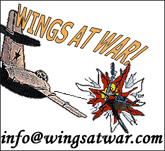|
USAAF
Lockhead P-38 Lightning
Probably the most distinctive front-line
single-seat
fighter of the war.
It was designed
in the late 1930s as a high-altitude
high-speed interceptor, hence the
resort to twin
engines. The engine
superchargers and radiators necessitated a twin boom configuration
allowing
the cockpit section to be quite spacious and very well
equipped.
It
meant the single 20mm cannon and four 0.5"
machineguns were concentrated along the aircraft's boresight
(straight ahead and not angled to a single concentration point
like wing-mounted guns).
The Lightening was surprisingly
manoeuvrable for such a large
plane.
Heavy
fighter losses in
the Mediterranean and Pacific theatres meant that the majority of
P-38s ended up there rather than in the west, but those that served
over France and Germany were put to a variety of tasks from ground
attack,
reconnaissance
and, before the advent of
the Mustang, as the main bomber escort.
ISA260a
Republic P-47 Thunderbolt
With war breaking out in Europe the USAAC (as the American air arm
was designated at the time) issued a requirement for a fighter of
exceptional performance and payload. Designers at Republic realised
that the only engine currently available that could meet these
requirements was the massive 2,000hp Pratt & Whitney radial engine
being fitted to medium bombers. The addition of a big turbosupercharger meant that the resulting P-47 Thunderbolt was the
largest single-seat fighter produced up to that point. However, even though it
was twice as heavy as other fighters its powerful engine gave it a
top speed of more than 400 mph and enabled it to be fitted with eight
0.5" machineguns.
By the start of 1943 the improved P-47C
reached England, many units swapping it for the Spitfire Mk.Vs they
had been allocated on arrival in Britain.
It had good overall performance and though the size of the 'Jug'
meant it was not the nimblest of fighters, especially at low level,
it did confer on it tremendous speed in a dive and meant it was able
to take a lot of punishment. The definitive model, of which
more were produced than any other US fighter sub-type, was the P-47D
fitted with a Hawker Typhoon bubble canopy. This first appeared in
early 1944. By then the P-51 had taken over the escort role as the
P-47 was not able to chaperone the bombers on the deep penetration
raids now being performed, and the Thunderbolt was instead used
mainly in
the ground attack role.
ISA284a & b
North American P-51 Mustang
At the start of the war the British asked
the North American Aviation company if they could build the Curtis
P-40 under licence for the RAF. NAA's president boldly stated that
they could build a much better plane than that; and they did.
The keys to the design were exceptionally clean aerodynamics
and massive fuel capacity. The original engine had limited
high-altitude performance so the RAF generally used the Mustang as a
ground attacker. When fitted with the same Merlin engine as the
Spitfire and British designed bubble canopy the P-51 Mustang proved
to be one of the best fighters of WW2 and near the apogee of
performance for a piston-engine aircraft. However, issues with the
engine and a propensity for gun jams (due to the thin wing forcing
the guns to be fitted at an angle to fit) meant it wasn't ready for
high-altitude combat with the USAAF until the P-51D arrived in
spring 1944.
The Mustang's prodigious range meant it could
escort the bombers all the way with fuel to spare. By the end of
1944 fourteen of the fifteen 8th
Air Force Fighter Groups operated P-51s.
The
Mustang was
armed with six 0.5" MGs. Over 15,000 were built and they accounted
for more enemy aircraft than any other type in the Allied
inventory.
ISA283b & c
(ISA283 & 283a in RAF service)
Douglas A-26 Invader
Designed as the successor to the effective
A-20 Havoc (called Boston in RAF service and still in limited use in
1944-45). The A-26 was powered by the same radial engine as the
B-25, B-26 and P-47 and was the fastest American bomber of the war.
Built in various configurations as either a light bomber
or dedicated ground attacker for taking on enemy armour and other
point targets the A-26 could be armed with as many as a devastating
fourteen fixed 0.5" machineguns firing forwards. Defensive armament
consisted of two twin 0.5" remote control turrets operated by a
single gunner. It could also be armed with rockets, or when
operating as a light bomber up to 5,000lbs of bombs.
It
first saw action over France in the autumn of 1944 and was such a
successful design that it served in Korea and Vietnam, under the new
designation of B-26, and is the only American bomber to see combat in three
major wars.
ISA294
Martin B-26 Marauder
Martin's 1939 proposal for a fast medium bomber was considered so
superior that the Airforce submitted an order before any
prototypes had been built. Though it ended the war with the lowest
loss rate per sortie of any USAAF aircraft its sleek design, slim
wings and powerful twin engines (the same as on the A-26, B-25 and
P-47) came at the expense of tricky low speed handling leading to
many accidents for the novice pilots being churned out of American
pilot schools.
Arriving in Britain in 1943, heavy losses on
conventional bombing raids soon saw it switched to direct support
for the invasion of France using medium altitude bombing.
Armed with twin 0.5" dorsal and tail turrets and a further three
flexible and four forward fixed machineguns. Maximum bomb load was
4,000lbs.
ISA264
Boeing B-17 Flying Fortress
The strategic bomber of the late 1930s was seen at the time in the
same vein as the modern nuclear missile; a deterrent that could rain
unstoppable mass death and destruction on anyone brave (or stupid)
enough to take you on. To
fulfill this prophecy a long range multi-engine
bomber was requested, able to deliver a ton of bombs 2,000 miles at a speed equal
to current fighters.
Boeing, desperate for orders,
poured all their resources into a design based on their all-metal
commercial airliner. The new plane more than fulfilled the
requirements but after several setbacks, including a couple of
crashes, the USAAC decided to cancel the order. To prove the design
Boeing instigated a series of high profile record breaking flights
and the order was reinstated with the first B-17s entering service
in 1939.
The first 8th AF Fortresses arrived in England in
August 1942 and daylight operations against targets in Europe began
soon after. Unescorted raids showed that even the best armed and armoured bombers were no match for defending fighters and it wasn't
until the advent of the P-51D escort that the B-17 really showed its
prowess.
It was an immensely sturdy bomber with a heavy
defensive armament. Long-ranged and stable in flight, the latter
allowing B-17 units to fly in compact hard to penetrate box formations.
The B-17's only drawback was a relatively light bomb load of 4,500lbs for
distance raids on Germany.
The last two years of war saw
the final version of the Flying Fortress operating in Europe, the
B-17G. This introduced the chin turret as a direct counter to enemy
head-on attacks, and an improved tail gunner position. By then the
B-17 was probably the bomber with the heaviest defensive armament of
the war bristling with thirteen 0.5" machineguns. In he Second World
War the Flying
Fortress delivered more bombs that any other US plane.
ISA280b
Consolidated B-24 Liberator
As the B-17 was about to go into production Consolidated was asked
to build Flying Fortresses under license. They instead decided to
come up with their own design, using a low drag shoulder mounted
high aspect wing (i.e. long and narrow) which would produce longer range and allow the
fitting of a bomb bay twice as large as the B-17, though in practice
the usual operational bomb load was nearer that of the B-17 so as
not to degrade range and speed.
In the campaign against
occupied Europe the B-24 had equal billing with the B-17, though most
crew would have preferred the tougher Flying Fortress over the 'flying boxcar'
which they considered less robust and more arduous to fly,
especially in formation. The USAAF however, valued the larger bomb
load and versatility of the Liberator.
The
definitive B-24J was armed with ten 0.5" machineguns in four twin
turrets plus two waist guns. Some 19,000 Liberators were
produced during the war, more than any other US aircraft.
ISA281b
RAF
Vickers-Supermarine Spitfire Mk. XIV
In the early 1930s Reginald Mitchell had proposed a monoplane
fighter based on Supermarine's experience in winning the Schneider
Trophy for seaplanes. Designed to a somewhat unadventurous Air
Ministry specification, Mitchell considered it too conservative and
it lost out to the equally orthodox Gloster Gladiator. As
a private venture (like its Merlin engine) he drew up plans for a
far more advanced, virtually all-metal monoplane interceptor,
designed to take on bombers. The prototype Spitfire first flew in
early 1936. The Air Ministry, this time impressed as by now Nazi
Germany was embarking on a massive rearmament, immediately ordered 310 Spitfires.
Two years later the Navy asked Rolls
Royce to designed a scaled up Merlin as the power plant for their multi-seaters.
It needed to be more powerful than the Merlin and have good low-level performance.
It was an obvious move to fit the resulting Griffon on a Spitfire
and after a fairly leisurely development the first Griffon powered
Spitfire, the Mk. XII, began operations in late 1942.
Though
blisteringly fast at low level, performance tailed off badly at
altitude and an improved Griffon was produced creating the Spitfire Mk. XIV. Armed
with two 20mm cannons and four 0.303" machineguns (or an alternative
machinegun fit of two 0.5") the Mk. XIV's only drawback was limited
range due to the thirsty Griffon. It
equipped six squadrons for the campaign in France, generally
operating in the air-superiority role.
ISA41d & ISA41e
Hawker Typhoon
Arguably the most effective ground attack
aircraft of the war. Hawker's design to find a successor to the
Hurricane began even before the Hurricane was put into service as it
was acknowledged even then that it had little development potential
and would quickly become obsolete. However, the Typhoon still opted
for a similar thicker wing than most contemporary fighters and
though this gave it strength and a larger space for armament and
fuel tanks, the extra drag somewhat degraded the performance,
especially at altitude and in a high-speed dive.
The outbreak of war meant that progress on the Typhoon slowed
whilst Hawkers concentrated on Hurricane production. Development was
handed over to the Gloster company and the first Typhoons flew from
Brockworth in Gloucester in the spring of 1941. By then the new Fw 190 was beating
up the RAF's Spitfire Vs and the Typhoon, soon nicknamed 'Tiffy' by
its pilots, was rushed into service before the Sabre engine was
fully matured and inherent structural problems had been addressed, issues that plagued the plane throughout its service life. It was
also soon noticed that its general outline and squat Sabre engine
made it look much like the Fw 190 it was taking on and large black
and white wing stripes were added to aid recognition. These were
later adopted by all Allied aircraft for the D-Day campaign and
beyond.
With the slow decline of the Luftwaffe and continuing
development of the Spitfire it was acknowledged that, like its
Hurricane predecessor, the Typhoon would be better used as a ground
attacker. Luckily, it was very much suited to the role being very
robust with a good low-level performance. By the end of 1943
rocket-armed Typhoons formed the main ground-attack weapon and there
were 18 squadrons ready for
Overlord.
By then the majority had been fitted with the innovative 'bubble'
canopy with much improved visibility, especially in the dangerous '6
o'clock' rear zone.
The Typhoon had a powerful
armament of four 20mm cannons and could carry up to 16 rockets or
2,000lbs of bombs.
ISA76 & ISA76a
Hawker Tempest
It soon became apparent that the Typhoon's
thick wing had a degrading effect on performance, particularly
in a fast dive, and a new thinner wing of a different, Spitfire-like,
shape produced the Tempest. The same four 20mm cannons, bubble
canopy and somewhat problematic Sabre engine were used but the
fuselage was strengthened following the Typhoon's structural
failure issues.
The result was a superb fighter, probably the
fastest piston-engine plane at low level, where it was even able to
dogfight with the Me 262. However, the preferred option against the
jet was a tactic
dubbed the 'Rat Scramble' whereby on being
alerted that jets were operating, the Tempests would attack them just as they were
landing.
The Tempest's main role, though, was armed
reconnaissance; hunting for targets of opportunity. Frontline squadrons began exchanging their
Typhoons from spring 1944.
ISA77 & ISA77a
North
American B-25 Mitchell
Named after the late and previously much derided 'Billy' Mitchell.
In post WW1 America Brigadier-General Mitchell was the most vocal of the
bombing advocates and the only man for whom an American warplane is
named. The B-25 medium bomber was not used in North West Europe
by
the USAAF but saw extensive action with the RAF in the campaign for
France.
It initially lost out to the A-20 Havoc but the
design was tweaked and eventually the B-25 was ordered at the same
time as the B-26. The RAF, Canadians and Free Dutch received around
900 B-25s from 1943 onwards and they first operated as conventional
medium bombers before switching to close support in
France. The B-25 was a tough and forgiving aircraft but lacked the
speed of the other American twin-engine bombers.
Many of the
later version Mitchell IIIs were fitted with multiple fixed forward
firing 0.5" machineguns (as on the A-26) as well as waist guns and a
twin turret mounted near the front able to add to the strafing fire.
The earlier Mitchell II had fewer forward guns and retained the
retractable ventral twin turret of earlier versions.
ISA249b
de Havilland Mosquito FB Mk. VI
The
British Air Ministry specification for a bomber that eventually led
to both the Halifax and Lancaster was approached in a different way
by the innovative de Havilland company. They instead came up with
the idea of a two-seat unarmed fast bomber, able to outrun any
pursuing fighter by virtue of its two Merlin engines and sleek
lines. Because
metal would no doubt be at a premium for island Britain during a war
De Havilland proposed to build their bomber using readily available
wood, as on their successful civil airliners. Though not as rigid,
wood has a strength to weight ration as good as the metals used on
most contemporary aircraft.
The resulting Mosquito (or 'Mossie'
to most) was an outstanding light bomber that saw service from late
1941 to the end of the war and beyond. At
virtually the same time as the bomber version was entering service a
fighter version was designed. By 1943 the fighter-bomber FB Mk. VI
was introduced fitted with a devastating armament of four 20mm
canons and four 0.303" machineguns mounted in the nose (taking up
half the bomb bay) and strengthened wings able to carry either
rockets or two 500lb bombs in addition to two 500lb bombs in the
reduced bomb bay.
The FB Mk. VI served with 2nd Tactical
Air Force supporting the Normandy battle and for special precision
raids such as attacks on Gestapo HQs and V-1 launch sites.
ISA75 & ISA75b
Avro Lancaster
Avro's initial
effort at a heavy bomber design was the twin-engine Manchester but this was found to be
horribly underpowered by its unreliable engines. When fitted with
four Merlins the Manchester was transformed into arguably the best
and most versatile night heavy bomber of the war and was the
mainstay of the RAF's bombing offensive against Germany. Performance
far exceeded expectations and it was rushed into service from early
1942.
Like all British bombers, the 'Lanc' was somewhat
under-armed in comparison to US bombers, fitted with two twin 0.303"
machinegun turrets and a rear quad 0.303" turret. Normal bomb load
was at least 14,000lbs, much more than its American B-17 and B-24
contemporaries. Most
Lancaster missions were at night but Bomber Command did provide
daylight support during the Normandy campaign, notably for Operation
Goodwood near Caen and against V-1 launch sites, often escorted by RAF
Mustangs. Daylight raids became more common towards the end of the
war as the fighter threat diminished.
ISA82
Handley Page
Halifax
Like the Lancaster, the Halifax
design also started off with two engines. It too finally appeared
with four Merlins but in 1943 the Halifax Mk. III started
production with four of the more powerful Hercules radial engines.
Armament was two quad 0.303" machinegun turrets (dorsal and rear)
and a single nose machinegun. Maximum bomb load was 13,000lbs.
Though it was generally considered inferior to the
Lancaster, although it actually had a lower mission loss rate and
better crew survivability, the RAF was loath to stop production as
it would have taken time to switch to the Lancaster. Bomber
Command's Halifax/Lancaster ratio progressively dropped from 1943
onwards but the Halifax still played a significant role in the
Normandy campaign and the drive through France.
ISA84a
LUFTWAFFE
Messerschmitt
Bf 109
Designed by Willy Messerschmitt after his company merged with the
Bayerische Flugzeugwerke (hence Bf rather than Me). The Bf 109 was a
lightweight cutting-edge development of a series of sporting
aircraft produced by Messerschmitt in the 1920s and early 30s. It
first flew in 1935 and saw action in the Spanish Civil War where the
many glitches were smoothed out and German pilots learned to tame
what could be a tricky plane to fly.
Like the Spitfire, the Bf 109 was much
improved by continuous development throughout the war. The later G
'Gustav' model, which saw service from 1943 to war's end, had an
improved airframe and much more powerful engine with power-boost to
increase high altitude performance. Various
'bolt on' kits and field modifications; including 20mm underwing
cannon pods, extra armour, bomb racks, rocket tubes etc. meant that
the Bf 109 could be tailored to fit a variety of tasks, though in
the main it operated in as clean a set-up as possible as it was the
Luftwaffe's main weapon against Allied fighters.
Flown by the
top three German aces, the type shot down more enemy planes than any
other aircraft in history. It was generally
armed with two heavy machineguns and a 20mm cannon, all fitted in
the nose section as the wings were somewhat slender for these larger
weapons.
The Bf 109 is one of the most produced aircraft ever
with over 24,000 Gustavs alone entering service, one of its main
virtues being that it was much simpler and cheaper to make than
other contemporary fighters. The final K mark of late 1944 was similar to
the G.
ISA141aa & b
Focke-Wulf Fw 190A Wurger
Designed by the legendary Kurt Tank (with a name like that he should
have been doing Panthers and Tigers) as a versatile all-rounder. The
original concept had two versions, one with the Bf 109's sleek
in-line engine and one with a hefty radial. The decision was taken
to choose the radial so as not to impinge on in-line engine
production.
Well armoured and armed the Fw 190, named
Wurger (Shrike), also had
exceptional speed and was fitted with a host of advanced flying
aids. The cockpit canopy offered much improved visibility over the Bf
109. The only disappointments were poor high altitude performance
and engine unreliability.
When first flown operationally in
late 1941 the Fw 190 was found to be superior to the Spitfire in
nearly all respects. Two years later the Fw 190 was pitted against
the first bombing raids by B-17s and B-24s based in
England, proving their worth by inflicting heavy losses.
Superbly versatile with a large range of armament options the Fw 190
was the most effective multi-role fighter of the war and over 20,000
of the numerous variants were built. Like the Bf
109 it was often fitted with
extra armour, bomb racks (generally for a single 500kg/1,100lb bomb), rocket tubes, gun pods, drop tanks etc. but could
haul around much more than the Messerschmitt. The Fw 190F/G version
even replaced the Stuka as the main ground attacker.
Normally armed with two 7.9mm machineguns in the nose and four 20mm
cannon in the wings.
ISA160
Focke-Wulf Fw 190A-8 Sturmbocke
By 1944 the Luftwaffe
found that their conventional fighters were increasingly vulnerable
to the massed fire put out by the tight combat boxes
now employed by the bomber
formations
and
that their own firepower was insufficient to shoot down the heavy
bombers they nicknamed
viermots or
'four mot(or)s'.
The twin-engine heavy
fighters such as the Bf 110 and Me 410, though more able to take
punishment, fell easy prey to the nippy escort fighters that now
protected every raid by the 8th Air Force. The
Sturmbocke
was designed to bridge the gap being heavily armed with 30mm cannons,
which
could usually
down a B-17 with
three
hits and a B-24 with one
or two,
and extra armour;
proof against anything but a lucky hit from a bomber's machineguns.
The extra weight still degraded performance so a
Bf 109 escort was usually needed, though at least
it
was manoeuvrable enough to have a chance, however slim, against the
Mustangs. The Sturmbocke
were organised in their own separate
Sturmgruppe units
which operated closely with their Bf 109 escorts.
Modifications to the normal Fw 190 armament were two
30mm cannons replacing two of the 20mm wing cannons and two
13mm heavy MGs instead of the 7.9mm
nose guns. A 21 cm one-shot rocket pod was often added under each
wing firing spin-stabilized shells with a timed fuse pre-set to
800m. This would cause damage to a bomber if it exploded within
about 30m of it. Just over 1,300 A-8s were built.
ISA160b
Focke-Wulf
Fw 190D
In order to improve high altitude
performance an in-line engine was added to a lengthened Fw 190
fuselage, producing the Fw 190D nicknamed 'Long-Nosed Dora'. The design
was meant as a stopgap until Kurt Tank's similar but superior Ta 152
could be properly developed (of which only 150 were completed
before the war ended).
Faster and better in a climb and dive
than the radial Fw 190. As it was intended to be used mostly as a
dogfighter armament was kept deliberately light at two nose 13mm
machineguns and two 20mm cannons in the wing roots. Some
'Doras'
were formed into
Platzsicherungstaffel
Me 262 airfield guard units.
1,800 were produced from the late
summer of 1944.
ISA160c
Messerschmitt Me 262 Schwalbe
In the endless debate over the greatest fighter of WW2 the Me 262 is
definitely a contender. Nothing had been seen like it and it was the
first ever operational jet. The design was an outstanding example of
alternative thinking, began even before WW2 started, and if
development had not been as leisurely it could have made a real
impact. As it was, by the time it entered combat in mid-1944 the war
was already lost. Allied bombing of fuel supplies and factories
(plus sabotage by the slave workforce) and Allied fighter sweeps over Me 262 airfields
meant that their overall impact on the war was negligible.
The initial project was to use Hans von Ohain's jet engine
to power a revolutionary fighter, aptly named the
Schwalbe ('Swallow'). As with any new technology it took a long time
to produce a viable jet engine and at first, with the war going well
for the Nazis, budget and resources were cut back on what was
considered an unnecessary luxury. The first successful flight was
July 1942 and by the time the Me 262 was in service Hitler had
decided to use it as a bomber. It was not until 1945 that the jet
was first let loose as a pure fighter, though initially the pilots were told not to
attack bombers as it was thought the unarmoured engines and large
fuel tanks would be vulnerable to defensive fire.
A typical sortie for
the Schwalbe was an attack
by 37 jets on an overwhelming force of over 1,200 bombers and half as
many escorting Mustangs in March 1945. Twelve bombers and one
Mustang were shot down for the loss of three jets. Over 1,300
American bombers made a raid on the Me 262 airfields in the
following month. 63 jets were scrambled shooting down ten B-17s but
27 jets were lost.
Though at least 100 mph faster than
any Allied fighter the jet engine's axial flow type compressor
was much more difficult to make and lack of certain metals made them
very unreliable and with an extremely short running life. The British and Americans
opted for the bulky and less efficient centrifugal compressor even
though this degraded performance in comparison with the German jets.
Jet engines of this period also consumed a lot of fuel so range was
limited. Just over 1,400 Me 262s saw service.
The Schwalbe was
Armed with four nose-mounted 30mm cannons and could also be fitted
with up to 24 rocket rails. Reconnaissance versions were normally
unarmed.
ISA180
Messerschmitt Me 262 Sturmvogel
In mid 1943 Hitler decided that the Me 262 should be configured as a
light bomber to attack the expected Allied invasion of France.
Therefore, in May 1944 the first squadron equipped with this
revolutionary warplane was a bomber outfit; former Ju 88 unit KG.51.
So at first most of the pilots transferred to jets had trained on
bombers.
The Sturmvogel ('Stormbird') only had two 30mm cannons but was given
extra fuel tanks and hard points for two 500kg (1,100lb) bombs.
ISA180
Messerschmitt Me 410 Hornisse
The disastrous Me 210, intended to replace the aging Bf 110 (with a
similar twin-engine twin-seat configuration) gained such a bad
reputation that when after many attempts a passable version was
finally produced it was given a new designation; Me 410 Hornisse
('Hornet')
In reality, the concept of the heavy fighter, or
in German parlance
Zerstorer
('destroyer'), had already
proved flawed. It
was certainly better than the Bf 110 and could carry a useful bombload in the ground attack role. Its guns could be devastating
against a bomber but the problem was getting through the swarms of
escort fighters and it proved to be easy meat.
Later Me 410s
sported a pair of heavy machineguns and two 20mm canons in the nose
but a suite of 'bolt on' kits for fitting under the nose meant there
was a great variety of armament configurations, ranging from a
massive 50mm cannon, two 30mm guns, and extra 20mm or heavy machineguns.
Alternatively, a camera pack could be fitted for
reconnaissance, a fairly common role when operating over the
Normandy battlefield. For defence two remote-control barbettes each
fitted with a single heavy machinegun covered the rear, operated by the observer.
The
Hornisse operated from early 1943 and just over 1,100 were made
before production ended in September 1944.
ISA163
Arado Ar 234
Blitz
Originally designed as the war's
ultimate untouchable reconnaissance plane the Blitz was a sleek
unarmed single-seater powered by the same two jet engines as the Me
262. The first reconnaissance mission was flown in August 1944 over
the Normandy beaches and bombing raids began at the end of the year
during the Battle of the Bulge.
The design showed
such promise that it was decided to produce a fast bomber version.
As there was no room fit a bomb bay the maximum bomb load of
3,300lbs was carried externally. There was scope to fit two remote
20mm cannons in the tail but these seemed not to have been used on
operations.
The Blitz was fast, though not as
quick as the Me 262, and surprisingly manoeuvrable at high speeds.
It is probable that less than 200 saw operational use.
ISA183 |
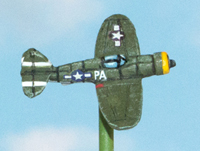
P-47D
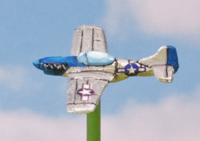
P-51D
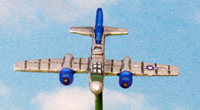
A-26
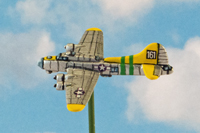
B-17G
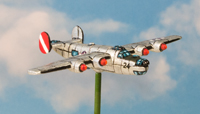
B-24J
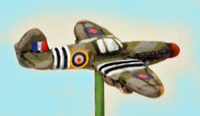
Spitfire
XIV
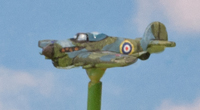
Typhoon
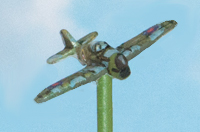
Tempest
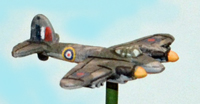
Mosquito
FB VI
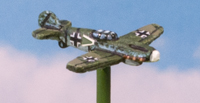
Bf 109G
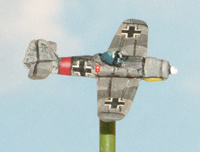
Fw 190A

Sturmbocke
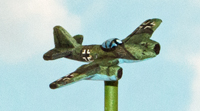
Me 262
|
![]()













